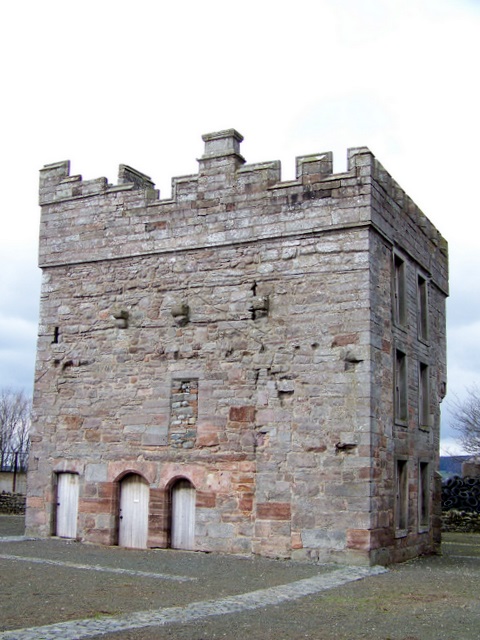Peel tower

|
| The peel tower at the north end of the village of Clifton (near Penrith) is a remnant of the old Clifton Hall. It serves as a reminder of the days of Scots raids from over the border, which is approximately 30 miles away. |
A peel tower or pele tower (not to be confused with the commemorative Peel Monument in Bury, Greater Manchester) is a freestanding structure built for defence. From about 1450 to 1600, these small houses or keeps were constructed in strategic locations in the UK, mainly as protection in Northern England and Scotland against the invasion of Edward I.
These small, square (or oblong) stone buildings had thick walls, which were meant to protect the occupants from sieges. Comprising three storeys, they included a storage area or garderobe for supplies and animals (on the ground floor), a hall and kitchen (on the first floor) and living, sleeping and strategic observation quarters (on the top floor). The roof was normally flat and could be used for protective purposes.
In all, approximately 90 peels were built. They were primarily constructed along the borders; many were built in the Tweed valley. Under a 1455 Act of Parliament, these specific peels (Fruid, Hawkshaw, Oliver, Polmood, Kingledoors, Mossfennan, Wrae, Quarter, Stanhope, Drumelzier, Tinnies, Dreva, Stobo, Dawyck, Easter Happrew, Lyne, Barnes, Caverhill, Neidpath, Peebles, Horsburgh, Nether Horsburgh, Cardrona, Kirna, and Elibank) had to have defensive features at the ready, including an iron basket and a smoke or fire signal.
In addition to their strategic function, peel towers were sometimes used as dwellings for lairds and landlords. They also served as temporary protective residences for townspeople when raiding parties threatened their villages. Some peels were incorporated into churches (as belltowers) or converted into castles. One in North Yorkshire was converted for a television programme into Hellifield Peel Castle bed and breakfast.
[edit] Related articles on Designing Buildings Wiki
Featured articles and news
One of the most impressive Victorian architects. Book review.
RTPI leader to become new CIOB Chief Executive Officer
Dr Victoria Hills MRTPI, FICE to take over after Caroline Gumble’s departure.
Social and affordable housing, a long term plan for delivery
The “Delivering a Decade of Renewal for Social and Affordable Housing” strategy sets out future path.
A change to adoptive architecture
Effects of global weather warming on architectural detailing, material choice and human interaction.
The proposed publicly owned and backed subsidiary of Homes England, to facilitate new homes.
How big is the problem and what can we do to mitigate the effects?
Overheating guidance and tools for building designers
A number of cool guides to help with the heat.
The UK's Modern Industrial Strategy: A 10 year plan
Previous consultation criticism, current key elements and general support with some persisting reservations.
Building Safety Regulator reforms
New roles, new staff and a new fast track service pave the way for a single construction regulator.
Architectural Technologist CPDs and Communications
CIAT CPD… and how you can do it!
Cooling centres and cool spaces
Managing extreme heat in cities by directing the public to places for heat stress relief and water sources.
Winter gardens: A brief history and warm variations
Extending the season with glass in different forms and terms.
Restoring Great Yarmouth's Winter Gardens
Transforming one of the least sustainable constructions imaginable.
Construction Skills Mission Board launch sector drive
Newly formed government and industry collaboration set strategy for recruiting an additional 100,000 construction workers a year.
New Architects Code comes into effect in September 2025
ARB Architects Code of Conduct and Practice available with ongoing consultation regarding guidance.
Welsh Skills Body (Medr) launches ambitious plan
The new skills body brings together funding and regulation of tertiary education and research for the devolved nation.
Paul Gandy FCIOB announced as next CIOB President
Former Tilbury Douglas CEO takes helm.























